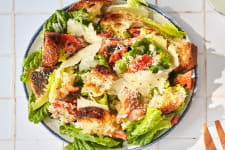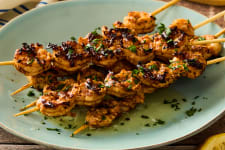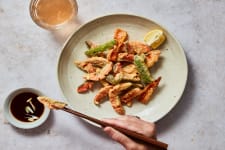Straddling summer and fall each year is a celebration of Latin America and all its multitudes — of culture, achievements, and how these influences have helped to shape our nation today. It’s always an especially proud and happy moment for me, having been born in the beautiful country of Colombia, where my husband Arron (WAC CEO & founder) and I were married.
And this time around, we’re thrilled to celebrate National Hispanic Heritage Month with WAC Designer Santiago Bueno, the Quito-born maestro whose keen eye keeps our communications (including this newsletter!) looking sharp.
Ecuador is one of the epicenters of ceviche, so Santi offered to adapt his abuela’s ceviche recipe for us using cooked spot prawns — a typical preparation of Ecuadorian-style ceviche, featuring one of our favorite Alaskan crustaceans.
And since both Santi and I have roots in Miami, a little chat about food and family was in order.
***
Monica: Where do you live?
Santi: I’m in Doral, Miami. Doral is a very heavy Venezuelan neighborhood, which I really like. I’ve been here for 4 years now, but my family has been living here for longer, so it always felt like a second home. (Now, it’s my first home, but it was always a second home.)
M: As you know, I grew up there, too. I was born in Bogota, but my family moved to Miami when I was 5 and I was there basically until the end of high school, and then I came to New York for college… and pretty much never went back.
S: It’s really nice to be here in Miami — it’s a very unique place. It’s never a boring day in South Florida.
M: There we agree for sure! Never a boring day.
So, let’s talk about food. For me, things from the Latin kitchen that enhance that home feeling are things like when you introduce yuca or platanos to any dish. They can instantly turn a regular fish soup into a Caribbean experience. That Caribbean Fish Stew that I make — because it’s got plantains and yuca, it somehow brings me back to the essential flavors that I grew up with. Yuca happens to be my favorite of all the potatoes. There’s something about it that, after a couple of days as leftovers, it starts to melt and give the soup more of that essence. And that’s true with plantains, too!
S: I was just going to say the same thing! Plantains are a staple of Latin cuisine, in a lot of different forms. You have it fried, grilled — and there are also chips, plantain chips. For me, these are so important for an Ecuadorian ceviche. If it’s a regular chip, you might as well not serve it.
I feel like Latin cuisine has a lot of rich, bold flavors. You always expect to hear about Mexican or Peruvian food (the most familiar ones) but in Miami you can find places with “not so popular” cuisines like Colombian food, Venezuelan food, Argentinian food — food from Guatemala, Central America. I was surprised to find the overall variety here. Miami has such a rich culture of Latin foods from all over.
I’m really happy to live in this Venezuelan neighborhood because I eat Venezuelan food all the time. It’s the best.
M: Delicious! I know. And speaking of plantains, we do have a recipe on our blog for that Banana Leaf Wrapped Pacific Halibut! The sweetness of the banana and the plantain…
S: The sweet and the salty. I feel like plantain goes well with salty stuff. It’s not overwhelming and elevates things very nicely with a little sweetness.
M: Other Latin flair moments with food are, like, diced avocado and chopped cilantro, a squeeze of citrus. Those three elements are so subtle, but when combined together, with some hot sauce — you basically have a Latin symphony. You don’t need to do much. You can literally grill or pan fry a piece of fish and add those elements, and suddenly you have this interesting Latin vibe. I mean, throw a tortilla in there and it’s a party!
S: Yeah, that’s why I really like my grandma’s recipe for ceviche because it has lime, it has cilantro, it has hot sauce, so all of the typical flavors of Latin cuisine in one dish.
I feel like ceviche is overwhelming for some people — it has so much flavor, that maybe some people are like “What is this cold soup, why is it so strong?” But for me, it’s just, like, amazing. It’s also, in Ecuadorian culture, a typical food that you enjoy after partying — it’s a good hangover meal. People love having ceviche after partying.
M: It’s a dish that is a party so it makes sense that it cures the party aftermath. It’s got salt content, it’s got protein, maybe it soaks everything up? I don’t know. [laughs]
Speaking of Venezuelan food, Venezuelans make some of the best arepas — I hope you’re eating lots of arepas.
S: Yeah, I love arepas. I feel like Latin American bakeries in general are very good, but Venzuelan bakeries are so underrated. I don’t know why they’re so underrated — I feel like these should be more well-known. Arepas, cachapas, they have a lot of different types of arepas that are almost like burgers…
M: They have more substance in Venezuela. I remember that they’re extra stuffed.
S: The filling barely fits! You cannot close it, it’s so full of stuff. It’s ridiculous.
M: My son eats arepas almost every morning. That’s his favorite food — so what I do, my hack to give him more nourishment, is to flake leftover salmon into the masa. It basically becomes pink-speckled arepas.
S: Ooooh, that sounds nice!
M: I don’t overdo it, so that they don’t turn too much into a “fish experience” but I do it enough so that I know he’s getting a little hit of the salmon. We call them “pink arepas.” It’s become a thing. He loves them. It’s a nice way to switch it up a little bit.
S: Is there any food in Miami that, when you’re back in town, you’re like “I’m going to have that for sure.”
M: One hundred percent. We go to the Colombian bakeries and pick up pandebono, pan de yuca…
S: I love pandebono. That’s like my childhood dish, that’s a very big dish in Ecuador.
M: Oh, I didn’t know that!
S: Ecuadorian and Colombian cuisine share a lot of similarities, especially with the baked stuff, so I know that feeling — once you have the coffee and the bread, it’s just… the perfect start.
M: You actually can’t resist it! Even if you happen to be going through a “no carbs” moment, something happens to the brain, where it’s like “I don’t care, I’m ignoring my no carbs moment. I cannot resist what’s in front of me and I cannot resist the smell.” And you just lean into surrendering.
I have to say, the Peruvian food in Miami is pretty epic, too. I haven’t quite found anything like that in New York, though I’m sure it exists. But in Miami, it’s unparalleled. I go straight to the Peruvian restaurants. Those seafood soups, like parihuela? Big seafood soup extravaganzas, full of flavor. And also the big seafood fried platters.
S: Oh, fried seafood is amazing. I don’t know how we make it differently in South America. Maybe it’s the breading. We make really good fried fish, like you said.
M: In Cartagena, where my grandmother’s from and where Arron and I were married, they’re famous for pescado entero frito. That’s one of the most delicious things you can eat. They make it perfect, I don’t know how, with your yuquita, your arroz de coco — that’s another thing, do you have that in Ecuador?
S: Yeah, but it’s different, we call it encocado. It’s like the sauce is already mixed with the fish — it’s a variation of coconut rice. It’s just the best. Even though I’ll always respect Peruvian food because it’s so good and so famous, for me, I’ll always have a soft spot for Ecuadorian food because I just grew up there and grew up with those flavors.
I do know what you mean though, the Peruvian food in Miami is, oof, it’s so good. It’s one of the best things you can get here.
M: I don’t think I’ve ever had a proper Ecuadorian meal!
S: There are not many places that you can find in Miami. You have to go to [Ecuador].
M: What is a classic seafood Ecuadorian meal that you like, other than ceviche?
S: I really like fried white fish. It’s like chicken fingers, but fish. It’s the kind of stuff I was eating as a kid with my grandmother growing up. It’s such a simple meal, but it’s so good. You cannot beat the basics like that, a properly cooked fish. My grandmother lives in Ecuador, so I don’t get access to her food that much, unfortunately.
There was one Ecuadorian restaurant that I would go to here in Miami, but it closed down after the pandemic and I haven’t found a new place yet. So, I’m homeless a little bit, but I have found a new home in Venezuelan cuisine. There are so many options. I even picked up some Venezuelan food today… and it’s waiting for me right there on the counter after this! I’m in good hands now.
M: How often do you get to go back home to visit?
S: I have a really strange visa thing, so I’m waiting to get my American citizenship. While I wait, I have very limited traveling permits that have to be renewed every year, so that’s very difficult. I can only travel once a year. I haven’t seen my grandma in two years! It’s terrible, because now she’s too old to travel, and it’s all on me now. I wish I could visit more. It’s such a short flight — hopefully next year.
M: It’s cool that we can, as human beings, connect with that aspect of our lives through the food that we eat. Talking about her recipe and her cooking, even though you’re not physically with her… you kind of are with her at that moment. There’s a nice connectivity that happens through those experiences.
S: Absolutely! My grandma was there with us in spirit when my mom, my aunt and I were making her ceviche recipe. We just felt like we were back in Manta, even though we were here in my boring kitchen. Food is definitely very inspiring and helps us connect. That’s for sure.
M: Is your grandmother the main food icon in your family?
S: Of course! She writes everything by hand, with all her tips and tricks. She’s very old fashioned, very strict with the measurements. She has a lot of famous recipes, a lot of seafood recipes, especially, because she’s from a port town called Manta on the coast of Ecuador — not from the mountains like me. She knows all of the good seafood.
And my granddad (her husband), he was full Italian. He moved to Ecuador from Italy after WWII, so she learned all of the Italian food as well. She knows all of the good Italian food, and all of the good Ecuadorian seafood. So I have been completely blessed. When I was little, I would spend summers, just spend a month or two months on the beach at my grandmother’s because I loved to be fed and to chill with her.
M: I mean, the Italian-Ecuadorian combo, what else do you need??
S: Yeah, I just need those two cuisines, and I’ll be set for a long time. This conversation is making me wish I could go back home, ASAP!
***
What a sincere delight to experience the above culinary mingle with a fellow Latino teammate — because for me personally, the most interesting form of learning happens through my senses, all of which are especially perked and inspired when delicious food is involved.
Vive Salvaje,
Monica
Pictured above: From top left: Young Santi making homemade pasta; a refreshing bowl of Santi’s Ecuadorian-style ceviche featuring wild-caught spot prawns, based on his abuela’s recipe; a glamor shot of spot prawn ceviche; Santi’s abuela and her nietos, with Santi on the far right of his cousins.






